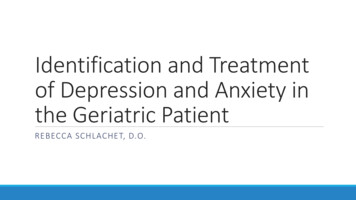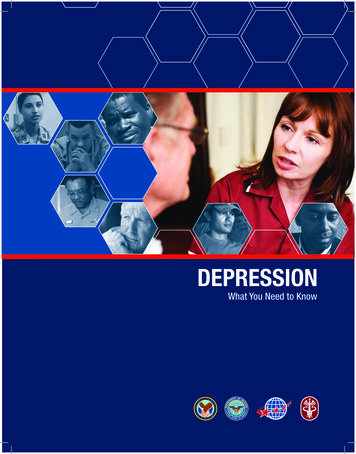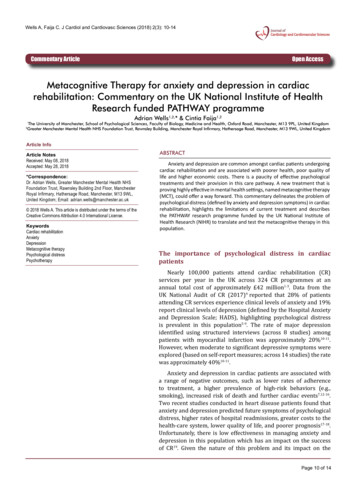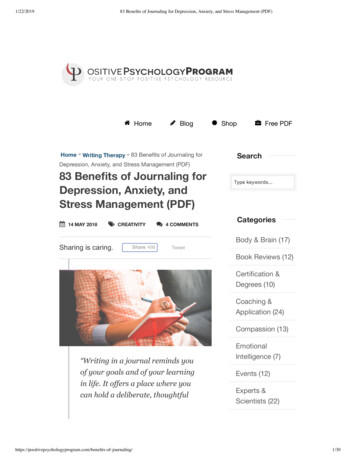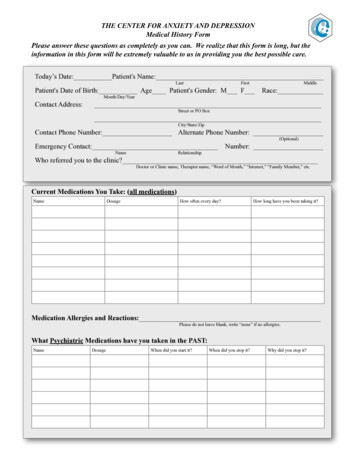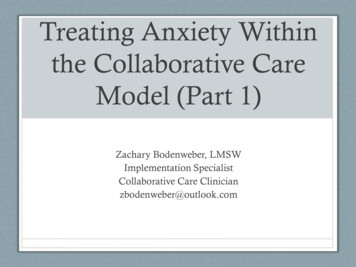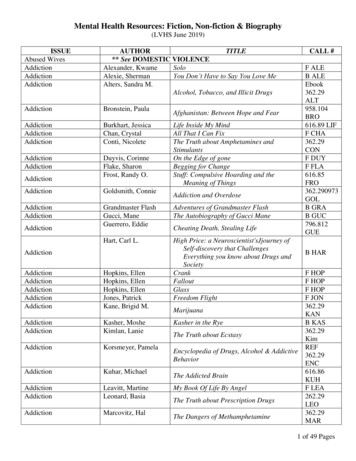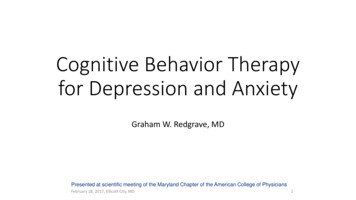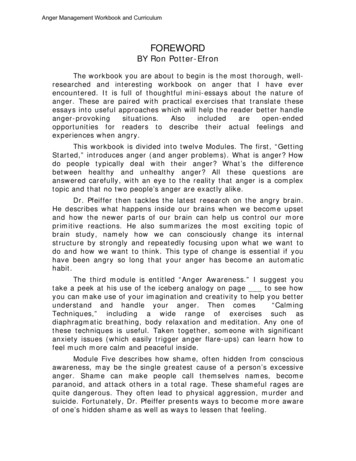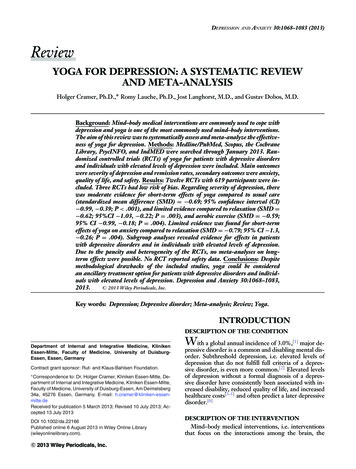
Transcription
DEPRESSION AND ANXIETY 30:1068–1083 (2013)ReviewYOGA FOR DEPRESSION: A SYSTEMATIC REVIEWAND META-ANALYSISHolger Cramer, Ph.D., Romy Lauche, Ph.D., Jost Langhorst, M.D., and Gustav Dobos, M.D.Background: Mind–body medical interventions are commonly used to cope withdepression and yoga is one of the most commonly used mind–body interventions.The aim of this review was to systematically assess and meta-analyze the effectiveness of yoga for depression. Methods: Medline/PubMed, Scopus, the CochraneLibrary, PsycINFO, and IndMED were searched through January 2013. Randomized controlled trials (RCTs) of yoga for patients with depressive disordersand individuals with elevated levels of depression were included. Main outcomeswere severity of depression and remission rates, secondary outcomes were anxiety,quality of life, and safety. Results: Twelve RCTs with 619 participants were included. Three RCTs had low risk of bias. Regarding severity of depression, therewas moderate evidence for short-term effects of yoga compared to usual care(standardized mean difference (SMD) 0.69; 95% confidence interval (CI) 0.99, 0.39; P .001), and limited evidence compared to relaxation (SMD 0.62; 95%CI 1.03, 0.22; P .003), and aerobic exercise (SMD 0.59;95% CI 0.99, 0.18; P .004). Limited evidence was found for short-termeffects of yoga on anxiety compared to relaxation (SMD 0.79; 95% CI 1.3, 0.26; P .004). Subgroup analyses revealed evidence for effects in patientswith depressive disorders and in individuals with elevated levels of depression.Due to the paucity and heterogeneity of the RCTs, no meta-analyses on longterm effects were possible. No RCT reported safety data. Conclusions: Despitemethodological drawbacks of the included studies, yoga could be consideredan ancillary treatment option for patients with depressive disorders and individuals with elevated levels of depression. Depression and Anxiety 30:1068–1083, C 2013 Wiley Periodicals, Inc.2013.Key words: Depression; Depressive disorder; Meta-analysis; Review; Yoga.INTRODUCTIONDESCRIPTION OF THE CONDITIONDepartment of Internal and Integrative Medicine, KlinikenEssen-Mitte, Faculty of Medicine, University of DuisburgEssen, Essen, GermanyContract grant sponsor: Rut- and Klaus-Bahlsen Foundation. Correspondenceto: Dr. Holger Cramer, Kliniken Essen-Mitte, Department of Internal and Integrative Medicine, Kliniken Essen-Mitte,Faculty of Medicine, University of Duisburg-Essen, Am Deimelsberg34a, 45276 Essen, Germany. E-mail: h.cramer@kliniken-essenmitte.deReceived for publication 5 March 2013; Revised 10 July 2013; Accepted 13 July 2013DOI 10.1002/da.22166Published online 6 August 2013 in Wiley Online Library(wileyonlinelibrary.com). C 2013 Wiley Periodicals, Inc.With a global annual incidence of 3.0%,[1]major depressive disorder is a common and disabling mental disorder. Subthreshold depression, i.e. elevated levels ofdepression that do not fulfill full criteria of a depressive disorder, is even more common.[2] Elevated levelsof depression without a formal diagnosis of a depressive disorder have consistently been associated with increased disability, reduced quality of life, and increasedhealthcare costs[3–5] and often predict a later depressivedisorder.[6]DESCRIPTION OF THE INTERVENTIONMind–body medical interventions, i.e. interventionsthat focus on the interactions among the brain, the
1069Review: Yoga for Depression: A Meta-Analysisrest of the body, the mind, and behavior,[7] are commonly used to cope with a wide range of depressionseverity[8] and yoga is one of the most commonly usedmind–body interventions.[9] Recently, a call has beenmade to rigorously evaluate the effectiveness of yoga inpsychiatry.[10–12]Yoga has its roots in Indian philosophy and has beena part of traditional Indian spiritual practice for around5000 years.[13] Traditional yoga is a complex intervention that comprises advice for ethical lifestyle, spiritual practice, physical activity, breathing exercises, andmeditation.[13–15] While the ultimate goal of traditionalyoga has been described as uniting mind, body, and spirit,yoga has become a popular means to promote physical and mental well-being.[13, 14] In North America andEurope, yoga is most often associated with physicalpostures (asanas), breathing techniques (pranayama),and meditation (dyana).[14] Different yoga forms haveemerged that put varying focus on physical and mentalpractices.[14] However, even exercise-based yoga interventions differ from purely gymnastic exercise as during yoga the practitioner focuses his mind on the postures with inner awareness and a meditative focus ofmind.[16, 17]Systematic reviews have shown that yoga can improve comorbid mental symptoms in physical conditions such as cancer,[18, 19] menopausal symptoms,[20] orpain.[21] As well, yoga has been shown to improve mental disorders such as anxiety disorders[22] and perhapsschizophrenia.[23, 24]HOW THE INTERVENTION MIGHT WORKDepression has been described as reflecting a primary disorder of biochemical and neurophysiological functions and there is evidence that alterationsin monoamine (noradrenaline, serotonin, dopamine)metabolism play a major role in the pathophysiologyof depression.[25] Other central neurotransmitters suchas gamma-aminobutyric acid (GABA) have also beenshown to be involved in depression.[26, 27] There is preliminary evidence from imaging studies that yoga practice can increase endogenous dopamine release in theventral striatum[28] and thalamic GABA levels.[29] Moreover, yoga practice was associated with increased plasmaserotonin in depressed patients.[30]Another proposed mechanism of yoga for depressionis the decrease of dysregulation in the hypothalamicpituitary-adrenal axis; this is the stress response.[27, 31]Many depressed patients present with increased levels of plasma cortisol that decrease to normal levels after effective treatment.[32] Findings on salivarycortisol levels in depressed patients are inconsistentwith some studies finding a higher cortisol awakeningresponse[33] and other studies showing flatter diurnalcortisol slopes.[34, 35] Studies have shown that yoga canreduce subjective stress in healthy adults[36] and reducelevels of plasma cortisol in individual with depression[30]or alcohol abuse.[37] In cancer patients, reduced morn-ing salivary cortisol levels have been found after a yogaintervention[38, 39] together with a steeper diurnal salivary cortisol slope.[39] The latter finding is however limited by the small sample size of the study.[39] While findings on effects of yoga on cortisol levels are inconsistentand limited by methodological shortcomings,[22] a regulation of the stress response might be involved in antidepressant effects of yoga.AIMS OF THE STUDYThe aim of this review was to systematically assessand meta-analyze the effectiveness and safety of different yoga forms in patients with depressive disorders andindividuals with elevated levels of depression.MATERIALS AND METHODSThe review was planned and conducted in accordance with PRISMA(Preferred Reporting Items for Systematic Reviews and MetaAnalyses) guidelines[40] and the recommendations of the CochraneCollaboration.[41]ELIGIBILITY CRITERIATypes of Studies. Randomized controlled trials (RCTs) andrandomized crossover studies (only data from the first active treatmentphase were used). No language restrictions were applied.Types of Participants.1. Adults with depressive disorders diagnosed by the Diagnostic andStatistical Manual, Fourth Edition (DSM-IV)[42] or the International Classification of Disease 10 (ICD-10).[43]2. (a) Adults with elevated levels of depression diagnosed by validated clinician-based or self-report depression symptom questionnaire, such as Hamilton Rating Scale for Depression,[44]the Beck Depression Inventory,[45] or the Center for Epidemiological Studies Depression Scale.[46](b) Adults with depression diagnosed using any other clinicianbased diagnosis criterion.Differences between the two types of participants were investigatedin a subgroup analysis.Studies involving participants with comorbid physical or mental disorders were eligible for inclusion, while studies that assessed depressionas a comorbid symptom of a specific physical or mental disorder (e.g.depression in cancer patients) were excluded.Types of Interventions.Experimental.1. Complex yoga interventions including physical exercise and atleast one of the following: breath control, meditation, and/orlifestyle advice (based on yoga theory and/or traditional yogapractices).2. Exercise-based yoga interventions (based on yoga theory and/ortraditional yoga practices) without breath control, meditation, orlifestyle advice.3. Yoga interventions including at least one of the following:breath control, meditation, and/or lifestyle advice (based on yogatheory and/or traditional yoga practices) without an exercisecomponent.Differences between the three types of experimental interventionswere investigated in a subgroup analysis.Depression and Anxiety
1070Cramer et al.No restrictions were made regarding yoga tradition, length,frequency, or duration of the program. Studies allowing individualco-interventions besides the intervention that was formally includedin the study were eligible.While mindfulness-based stress reduction (MBSR) is rooted inBuddhist spiritual tradition, it has been developed in the USA as ahighly structured secular behavioral medicine intervention.[47] MBSRis mainly based on mindfulness meditation; although gentle yogapostures are included in the MBSR program, they are only a minor part of the intervention.[47] Mindfulness-based cognitive therapy (MBCT) has been specifically developed for relapse preventionin major depression and combines MBSR with cognitive-behavioraltechniques.[48] Therefore, it is normally regarded as part of the“third wave” of cognitive-behavioral therapy.[49] While there areconceptual and technical overlaps, MBSR and MBCT are mostlyregarded as distinct from yoga and not normally included in reviews of yoga interventions.[19–24, 50] On the other hand, reviewson mindfulness-based interventions normally do not include yogainterventions.[49, 51–53] As the effects of those interventions on depression have been extensively reviewed,[49, 52, 53] studies on MBSRor MBCT for depression were excluded from this review.Control. Studies comparing yoga to usual care or any active controlintervention were eligible. Separate meta-analyses were conducted fordifferent control conditions.Types of Outcome Measures. For inclusion, RCTs had to assess at least one primary outcome:1. Improvement in the severity of depression or symptoms of depression, measured by self-rating scales such as the Beck DepressionInventory,[45] or by clinician-rated scales, such as the HamiltonRating Scale for Depression,[44] or any other validated scale.2. Improvement in depression measured as the number of patients who reach remission as measured by Beck DepressionInventory,[45] Hamilton Rating Scale for Depression,[44] or anyother validated depression scale.Secondary outcomes included:1. Improvement in anxiety symptoms, measured using clinician-ratedscales, such as the Hamilton Anxiety Scale[54] or self-report scales,such as the Beck Anxiety Inventory[55] or any other validated scale.2. Health-related quality of life, measured by any validated scale suchas the Medical outcomes study short-form 36.[56]3. Safety of the intervention assessed as number of adverse effects.SEARCH METHODSThe following electronic databases were searched from their inception through January 17, 2013: Medline/PubMed, Scopus, theCochrane Library, PsycINFO, and IndMED. The literature searchwas constructed around search terms for “yoga” and search termsfor “depression.” For PubMed, the following search strategy wasused: (“Depression”[Mesh] OR “Depressive Disorder”[Mesh] OR depress*[Title/Abstract] OR dysthymi*[Title/ Abstract]) AND (“Yoga”[Mesh]OR yog*[Title/Abstract] OR asana*[Title/Abstract] OR pranayama[Title/Abstract] OR dhyana[Title/Abstract]). The search strategy was adaptedfor each database as necessary. The System for Information onGrey Literature in Europe (http://www.opengrey.eu/), CAM-Quest(www.cam-quest.org), CAMbase (http://www.cambase.de), and ResearchGate (www.researchgate.net) were additionally searched to locate gray literature.Reference lists of identified original articles or reviews weresearched manually. Additionally, the tables of contents of the International Journal of Yoga Therapy and the Journal of Yoga and PhysicalTherapy were reviewed.Depression and AnxietyAbstracts identified during literature search were screened by tworeview authors independently. Potentially eligible articles were read infull by two review authors to determine whether they met the eligibility criteria. Disagreements were discussed with a third review authoruntil consensus was reached. If necessary, additional information wasobtained from the study authors.DATA EXTRACTION AND MANAGEMENTData on patients (e.g. age, gender, diagnosis), methods (e.g.randomization, allocation concealment), interventions (e.g. yogatype, frequency, and duration), control interventions (e.g. type,frequency, duration), outcomes (e.g. outcome measures, assessmenttime points), and results were extracted by two authors independentlyusing an a priori developed data extraction form. Discrepancieswere discussed with a third review author until consensus wasreached. If necessary, the study authors were contacted for additionalinformation.RISK OF BIAS IN INDIVIDUAL STUDIESRisk of bias was assessed by two authors independently using therisk of bias tool proposed by the Cochrane Back Review Group.[57]This tool assesses risk of bias on the following domains: selection bias,performance bias, attrition bias, reporting bias, and detection biasusing 12 criteria. For each criterion, risk of bias was assessed as (1)low risk of bias, (2) unclear, (3) high risk of bias. Conflicts of opinionwere discussed with a third review author until consensus is reached.If necessary, additional information was retrieved from the study authors. Studies that met at least six of the 12 criteria and had no seriousflaw were rated as having low risk of bias. Studies that met fewer thansix criteria or had a serious flaw were rated as having high risk ofbias.[57]DATA ANALYSISEffects of yoga compared to different control interventions wereanalyzed separately as were short-term and long-term effects. Shortterm outcomes were defined as outcome measures taken closest to12 weeks after randomization and long-term outcomes as measurestaken closest to 12 months after randomization.Assessment of Overall Effect Size. Meta-analyses were conducted using Review Manager 5 software (Version 5.1, The NordicCochrane Centre, Copenhagen) if at least two studies assessing thisspecific outcome were available. As only a limited number of studieswas expected to be eligible and random effects tests are regarded asonly approximate if the number of studies is small,[58] a fixed effectsmodel was used.For continuous outcomes, standardized mean differences (SMD)with 95% confidence intervals (CIs) were calculated as the difference inmeans between groups divided by the pooled standard deviation.[41, 59]Where no standard deviations were available, they were calculatedfrom standard errors, CIs or t-values,[41] or attempts were made toobtain the missing data from the trial authors by email.A negative SMD was defined to indicate beneficial effects of yogacompared to the control intervention for all outcomes (e.g. decreaseddepression) except for health-related quality of life where a positiveSMD was defined to indicate beneficial effects (e.g. increased wellbeing). If necessary, scores were inverted by subtracting the mean fromthe maximum score of the instrument.[41]Cohen’s categories were used to evaluate the magnitude of the overall effect size with (1) SMD 0.2 to 0.5: small; (2) SMD 0.5 to 0.8:medium, and (3) SMD 0.8: large effect sizes.[59] Levels of evidencewere determined as (1) strong evidence: consistent findings amongmultiple RCTs with low risk of bias; (2) moderate evidence: consistentfindings among multiple high-risk RCTs and/or one low-risk RCT;
Review: Yoga for Depression: A Meta-Analysis(3) limited evidence: one RCT with high risk of bias; 4) conflictingevidence: inconsistent findings among multiple RCTs; and (5) No evidence: no RCTs.[60]For dichotomous outcomes, risk ratios (RR) with 95% CI werecalculated by dividing the risk of event in the experimental group (i.e.the number of participants with the respective outcome divided bythe total number of participants) by the risk of event in the controlgroup.[41]ASSESSMENT OF HETEROGENEITYStatistical heterogeneity between studies was analyzed using theI2 statistics, a measure of how much variance between studies canbe attributed to differences between studies rather than chance. Themagnitude of heterogeneity was categorized as (1) I2 0–24%:low heterogeneity; I2 25–49%: moderate heterogeneity; I2 50–74%: substantial heterogeneity; and I2 75–100%: considerableheterogeneity.[41, 61] The χ 2 test was used to assess whether differences in results are compatible with chance alone. Given the low powerof this test when only few studies or studies with low sample size areincluded in a meta-analysis, a P-value .10 was regarded to indicatesignificant heterogeneity.[41]SUBGROUP AND SENSITIVITY ANALYSESSubgroup analyses were conducted for:1. Type of participants (patients with depressive disorders; individualswith elevated levels of depression).2. Type of yoga intervention (complex; exercise-based; meditationbased).To test the robustness of significant results, sensitivity analyses wereconducted for studies with high versus low risk of bias. If statisticalheterogeneity was present in the respective meta-analysis, subgroupand sensitivity analyses were also used to explore possible reasons forheterogeneity.RISK OF BIAS ACROSS STUDIESIf at least 10 studies were included in a meta-analysis, funnelplots were generated using Review Manager 5 software. Funnel plotsare scatter plots of the intervention effect estimates from individualstudies against the studies’ sample size.[41] As the precision of effectestimates normally increases with sample size, effect estimates fromstudies with smaller size will scatter more widely than those of largerstudies. Unpublished smaller studies with nonsignificant results,i.e. publication bias, will therefore result in asymmetrical funnelplots.[41, 62] Meta-analyses with substantial publication bias will likelyoverestimate the effect sizes.[41, 62] Publication bias was assessed byvisual analysis with roughly symmetrical funnel plots regarded toindicate low risk and asymmetrical funnel plots regarded to indicatehigh risk of publication bias.[36, 52]RESULTSLITERATURE SEARCHNine hundred and sixty-three records were retrievedthrough the literature search; two additional recordswere retrieved from reference lists of identified originalarticles; and one additional record was retrieved fromthe Journal of Physical Therapy and Yoga. After exclusion of duplicates, 923 records were screened and 896records were excluded because they were no RCTs, par-1071ticipants were not depressed, and/or yoga was not anintervention. Out of 27 full texts assessed for eligibility, 15 articles were excluded, because they were notrandomized,[63–65] participants did not need to be depressed to be included,[66–75] or no relevant outcomemeasures were assessed.[76, 77] Twelve full-text articleswith a total of 619 patients were included in the qualitative analysis.[78–89] One RCT did not provide rawdata of outcome measures; and these data could notbe retrieved from trial authors.[78] Two RCTs hadunique control groups that could not be compared toother RCTs in meta-analysis.[80, 82] Finally, nine studies with 452 patients were included in the meta-analysis(Fig. 1).STUDY CHARACTERISTICSCharacteristics of the sample, interventions, outcomeassessment and results are shown in Table 1.Setting and Participant Characteristics. Of the12 RCTs that were included, six originated from Asia(five from India[78, 82, 83, 85, 87] , and one from Iran[86] ),five from North America (USA),[79–81, 84, 89] and onefrom Europe (UK).[88] Patients were recruited frompsychiatric outpatient services,[78, 87] psychiatric inpatient services,[82, 85] local physicians and mental healthprofessionals,[79] medical school prenatal ultrasoundclinics,[80, 81] community cultural centers for olderwomen,[86] student hostels,[83] or by press releases.[79]Two RCTs did not report the setting patients wererecruited from.[88, 89] One study each included onlyolder women,[86] female students,[83] or dementiacaregivers[84] ; and two studies included only women withprenatal depression.[80, 81]Six RCTs included patients with a DSM-IV diagnosis of a depressive disorder[79–82, 85, 87] ; three ofthose included only patients with a major depressiondiagnosis.[82, 85, 87] Six RCTs included adults with elevated levels of depression diagnosed by the Hamilton Rating Scale for Depression,[82] the Clinical Interview Schedule,[88] the Beck Depression Inventory,[89]the Yesavage Geriatric Depression Scale,[86] the Amritsar Depressive Inventory and the Zung Depression SelfRating Scale,[83] or a clinician.[78]Patients’ mean age ranged from 21.5 years to 66.6years with a median age of 33.7 years. Between 36.7and 100.0% (median: 76.5%) of patients in eachstudy were female. Race was reported in only oneRCT.[80]Intervention Characteristics. Three RCTs usedcomplex yoga interventions including physical posturesand either breathing exercises or meditation; one RCTeach used the Inner Resources program,[79] laughteryoga,[87] and the Broota Relaxation Technique.[78]Four RCTs used exercise-based yoga interventions;one of those used Iyengar yoga,[89] the other threeRCTs did not define the yoga form used.[80, 81, 88] Theremaining five RCTs used yoga without physicalcomponent including Kirtan Kriya,[84] Sudarshan KriyaDepression and Anxiety
1072Cramer et al.Figure 1. Flowchart of the results of the literature search.Yoga,[82, 85] Sahaj yoga meditation,[87] and Shavasanayoga.[83] The length of the programs ranged from 3days to 12 weeks with a median of 8 weeks. Yoga wasconducted by certified yoga teachers,[81, 83, 85, 87, 89] orclinical psychologists.[79] Four RCTs did not report thequalification of interventionists.[78, 82, 86, 88]Six RCTs compared yoga to no specific treatment, including no treatment,[83, 89] standard care,[58] or a controlgroup that was not further specified.[78, 79, 86] Four RCTscompared yoga to a relaxation intervention includingprogressive muscle relaxation,[78] listening to relaxationmusic,[71] partial Sudarshan Kriya Yoga,[85] and sittingquietly.[87] Two RCTs compared yoga to aerobic exercise including stretching and running.[86, 88] One RCTeach compared yoga to a pharmacological treatment,[82]group therapy with hypnosis,[79] unsupervised socialsupport groups,[80] electroconvulsive therapy,[82] ormassage.[81] Control interventions were conducted bylicensed massage therapists,[81] psychiatrists,[79] clinicalpsychologists,[79] or yoga teachers.[85] Four RCTs didnot report the qualification of interventionists.[78, 82, 86, 88]Antidepressant comedication was allowed in threeRCTs[78, 79, 87] ; any co-intervention in one RCT[86] ; andDepression and Anxietyno co-interventions in six RCTs.[78, 80, 82, 83, 85, 89] TwoRCTs did not report co-interventions.[81, 86]OUTCOME MEASURESAll 12 RCTs assessed severity of depression using the Beck Depression Inventory,[82, 85, 88, 89] theHamilton Rating Scale for Depression,[79, 82, 84, 87] theYesavage Geriatric Depression Scale,[86] the CornellDysthymia Rating Scale Self Report,[79] the Centerfor Epidemiological Studies Depression Scale,[80, 81] theClinical Interview Schedule,[88] the Zung DepressionSelf Rating Scale,[83] the Edinburgh Postnatal Depression Scale,[80] or an unvalidated symptom check list.[78]Remission rates were assessed by four RCTs.[79, 82, 83, 87]Five RCTs assessed anxiety using the Beck AnxietyInventory,[85] the Hamilton Anxiety Rating Scale,[82] orSpielberger’s State Anxiety Inventory.[80, 81, 89] Healthrelated quality of life was assessed by one RCT usingthe Short Form 36 Health Survey mental componentscore.[84] While all RCTs reported short-term effects,only two RCTs also reported long-term effects.[79, 80] NoRCT reported safety data.
None92 prenatallydepressed femalesDSM IVYoga: 24.4 yearsSupport group:24.5 years84 prenatallyNot specifieddepressed femalesDSM IV; depressionfrom onset ofpregnancy orlonger26.6 yearsField et al.(2012a) (80)Field et al.(2012b) (81)52 individuals withdepressionDSM IV, 2 years withoutremission50.4 14.8 yearsButler et al.(2008) (79)Antidepressantmedicationallowed, nopsychotherapy30 individuals withdepressionDiagnosed byclinician19–49 a & Dir(1990) (78)ReferencePatients (N,Diagnosis, Age)TABLE 1. Characteristics of the included studiesYoga12 weeks, 2 20 min/week (postures)Yoga12 weeks, 1 20 min/week(postures)Broota RelaxationTechnique3 day session(breathing exercises,postures,autosuggestion)Mediation and HathaYoga8 weeks, 1 2 hr/week,1 4 hr retreat, 1 2 hr booster session inweek 12 (meditation,postures, breathingexercises, mantrarepetition, discussion)Home practice (6 30 min per week)TreatmentResults1) Significantdifference favoringyoga over controlgroup2) Significantdifference favoringyoga over controlgroup1) Massage12 weeks12 weeks, 2 20 min/week(head, back, legs,arms)2) Standard prenatalcareNot specified1) CES-D2) STAI1) No significant1) No significantgroup differencesgroup differences2) No significant2) No significantgroup differencesgroup differences1) CES-D, EPDSSocial support group 1) 12 weeks2) Postpartum 2) STAI12 weeks, 1 20 min/week1) HAM-D;1) No significant1) No significantCDRS-SRgroup differencesgroup differences2) MDE; Remission2) MDE: No 2 monthssignificant groupdifferences;Remission:Significantdifference favoringyoga over controlgroupLong term1) 6 months1) Group therapy2) 9 monthswith hypnosis10 weeks, 1 1.5 hr/week, 1 2 hr boostersession in week 12(hypnosis,self-hypnosis,discussion)2) Control groupNot specified1) Significantdifference favoringBroota RelaxationTechnique overcontrol groupShort term1) Symptom checklist (no validatedinstrument)Followup3 days1) Progressivemuscle relaxation3 day session2) Control groupNot specifiedControlIntervention groups (program length,frequency, duration)Outcome measures1. Severity2. Remission3. Anxiety4. Health-relatedquality of life5. SafetyReview: Yoga for Depression: A Meta-Analysis1073Depression and Anxiety
Depression and Anxiety8 weeksYogic meditationRelaxation musicKirtan Kriya8 weeks, 7 12 min/8 weeks, 7 12 min/weekweek(Instrumental music(Mudras, chanting,using a CD)silent meditation,breathing meditationusing a CD)49 family caretakers Not specifiedwithmild-moderatedepressionHRSD between5 1760.3 14.8 years30 daysLavretsky et al.(2012) (84)1) HAM-D2) SF-361) ZGS2) Free fromsymptoms ofdepressionWait-list30 daysShavasana yoga30 days, 30 min/day(Relaxation, breathingexercises)50 female students No other therapyallowedwith severedepression since2–3 monthsADI, ZGS, personalinterview schedule20–25 yearsKhumar et al.(1993) (83)1) BDI; HAM-D2) RemissionFollowupOutcome measures1. Severity2. Remission3. Anxiety4. Health-relatedquality of life5. Safety1. Electro-convulsive 4 weekstherapy (ECT)4 weeks, 3 /week2. Imipramin(IMN)4 weeks, 1 150 mg/dayControlSudarshan Kriya Yoga(SKY)4 weeks, 6 45 min/week (breathingexercises, meditation)Treatment45 individuals with NonemelancholicdepressionDSM IV, HRSD 17SKY: 36.0 7.8 yearsECT: 36.7 2.5 years IMN:43.4 11.9 yearsCo-interventionsIntervention groups (program length,frequency, duration)Janakiramaiahet al. (2000)(82)ReferencePatients (N,Diagnosis, Age)TABLE 1. Continued1) Significantdifference favoringyoga overrelaxation (15 vs. 5responders)2) Significantdifference favoringyoga overrelaxation (12 vs. 3responders)1) Significantdifference favoringyoga over wait-list2) 11 students in theyoga group; 0students in thewait-list group1) Significantdifference favoringECT over SKY2) No significantgroup differencesShort termResultsLong term1074Cramer et al.
Co-interventions70 elderly (60–80years) withdepressionGDS 1066.56 years30 individuals (18– Antidepressantmedication45 years) withmajor depressionDSM IVYoga: 31.87 8.78 yearsControl group:31.67 8.46 yearsSharma et al.(2005) (87)Not specified30 individuals (18– None60 years) withmajor depressionDSM IV, HRSD 18SKY: 29.5 8.2yearsPartial SKY: 34.2 11.7 yearsPatients (N,Diagnosis, Age)Shahidi et al.(2010) (86)Rohini et al.(2000) (85)ReferenceTABLE 1. ContinuedSahaj yoga meditation8 weeks, 3 30 min/week(meditation)Laughter Yoga10 30 min.(Stretching, yogicbreathing, laughter)Sudarshan Kriya Yoga(SKY)4 weeks(breathing exercises,meditation)TreatmentFollowupControl group8 weeks, 3 30 min/week(sitting quietly)1. Aerobic exercise10 30 min.(jogging,stretching)2. Control groupNot specified8 weeksNot specified4 weeksPartial SudarshanKriya Yoga(partial SKY)4 weeks(breathing exercises,meditation)ControlIntervention groups (program length,frequency, duration)1) HAM-D2) RemissionHAM-D3) HAM-A1) GLS1) BDI2) BAIOutcome measures1. Severity2. Remission3. Anxiety4. Health-relatedquality of life5. SafetyResults1) Significantdifference favoringyoga over controlgroup2) Significantdifference favoringyoga over controlgroup3) Significantdifference favoringyoga over controlgroup1) Significantdifference favoringyoga over controlgroup; nodifference betweenyoga and exercise1) No significantgroup differences2) No significantgroup differencesShort termLong termReview: Yoga for Depression: A Meta-Analysis1075Depression and Anxiety
Depression and Anxiety1) BDI; POMSDepression2) STAI; POMSanxiety1) BDI, CIS2) ST
DEPRESSION AND ANXIETY 30:1068-1083 (2013) Review YOGA FOR DEPRESSION: A SYSTEMATIC REVIEW AND META-ANALYSIS Holger Cramer, Ph.D., Romy Lauche, Ph.D., Jost Langhorst, M.D., and Gustav Dobos, M.D. Background: Mind-body medical interventions are commonly used to cope with depression and yoga is one of the most commonly used mind-body interventions.

